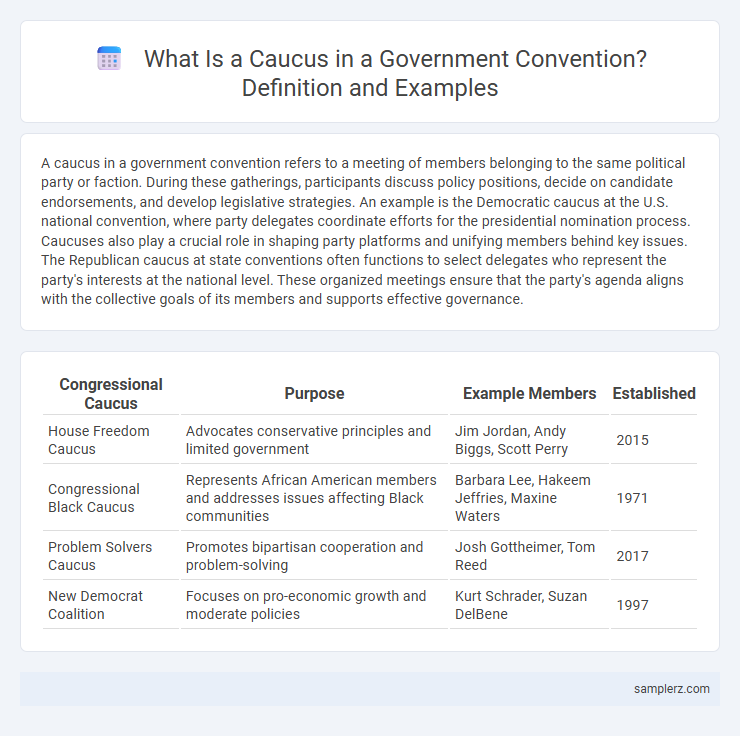A caucus in a government convention refers to a meeting of members belonging to the same political party or faction. During these gatherings, participants discuss policy positions, decide on candidate endorsements, and develop legislative strategies. An example is the Democratic caucus at the U.S. national convention, where party delegates coordinate efforts for the presidential nomination process. Caucuses also play a crucial role in shaping party platforms and unifying members behind key issues. The Republican caucus at state conventions often functions to select delegates who represent the party's interests at the national level. These organized meetings ensure that the party's agenda aligns with the collective goals of its members and supports effective governance.
Table of Comparison
| Congressional Caucus | Purpose | Example Members | Established |
|---|---|---|---|
| House Freedom Caucus | Advocates conservative principles and limited government | Jim Jordan, Andy Biggs, Scott Perry | 2015 |
| Congressional Black Caucus | Represents African American members and addresses issues affecting Black communities | Barbara Lee, Hakeem Jeffries, Maxine Waters | 1971 |
| Problem Solvers Caucus | Promotes bipartisan cooperation and problem-solving | Josh Gottheimer, Tom Reed | 2017 |
| New Democrat Coalition | Focuses on pro-economic growth and moderate policies | Kurt Schrader, Suzan DelBene | 1997 |
Understanding Caucuses in Political Conventions
Caucuses in political conventions serve as essential forums where party members gather to discuss policy priorities, select candidates, and unify their platforms. The Iowa Caucus exemplifies this process by combining public deliberation and voting, highlighting how grassroots engagement shapes delegate allocation and influences national party strategies. Understanding these gatherings reveals the critical role caucuses play in fostering party cohesion and directing the nomination process.
Historical Origins of Caucuses in Government
Caucuses in government originated in the early 19th century as informal meetings where members of political parties in the United States Congress gathered to discuss policy and select party leaders. The term "caucus" stems from Native American Algonquian language meaning a counselor or advisor, reflecting its roots in collaborative decision-making. Historically, these gatherings evolved into structured bodies that influence legislative agendas and candidate nominations, playing a critical role in shaping American political parties.
How Caucuses Operate Within Conventions
Caucuses operate within conventions as organized meetings where party members gather to discuss and select delegates who represent their preferences in the nomination process. These gatherings emphasize consensus-building and direct voter participation, allowing for in-depth deliberation on candidates and policy platforms. The outcomes influence delegate allocation, shaping party nominations and strategies in general elections.
Notable Examples of Caucus Procedures
Notable examples of caucus procedures include the Iowa Democratic caucuses, where participants gather in precinct locations to openly discuss and physically align with their preferred candidates, making the process highly interactive and transparent. Another example is the Nevada caucuses, which incorporate both initial preference groups and realignment phases, allowing voters to switch support if their first choice lacks viability. These procedures emphasize grassroots engagement and local-level voter interaction, distinguishing them from primary elections.
The Role of Delegates in Caucus Events
Delegates in caucus events play a critical role by representing their constituents' interests and participating in decision-making processes to select party nominees or develop policy platforms. These delegates engage in discussions, negotiate alliances, and cast votes that influence the direction of the party at conventions. Their involvement ensures that grassroots perspectives are integrated into broader party strategies and candidate endorsements.
Impact of Caucuses on Policy Decisions
Caucuses in government conventions, such as the Congressional Black Caucus (CBC) and the House Freedom Caucus, significantly shape policy decisions by uniting members around specific ideological or demographic interests. These caucuses leverage collective voting power and strategic negotiations to influence legislation, prioritize resource allocation, and set the legislative agenda. Their impact extends to advancing civil rights, healthcare reform, fiscal policies, and other critical areas through coordinated advocacy and policymaking efforts.
Major Party Caucus Examples in National Conventions
Major party caucus examples in national conventions include the Democratic Caucus and Republican Caucus, which play critical roles in shaping party platforms and selecting presidential nominees. These caucuses involve delegates from each state who discuss, debate, and vote on key issues and candidates, reflecting the party's strategic priorities. The impact of these caucuses extends to establishing party unity and mobilizing support for general election campaigns.
Case Study: Democratic and Republican Caucuses
Democratic and Republican caucuses exemplify distinct approaches to candidate selection and party strategy during conventions, where Democratic caucuses emphasize proportional delegate allocation based on candidate support in local meetings, and Republican caucuses often employ winner-takes-all or hybrid systems reflecting state-level preferences. These processes influence the momentum and delegate count for presidential nominees, shaping the overall convention dynamic and party platform development. Understanding these caucus mechanisms reveals critical differences in grassroots participation and party control within the American political system.
Challenges and Criticisms of Convention Caucuses
Convention caucuses often face challenges such as limited transparency and potential exclusion of minority viewpoints, which can undermine the democratic process. Criticisms highlight that these gatherings may consolidate power among established party elites, reducing broader participation and fostering factionalism. The lack of standardized rules across caucuses further complicates accountability and fair representation.
The Future of Caucus Systems in Government Conventions
The future of caucus systems in government conventions highlights increasing emphasis on inclusivity, transparency, and digital integration to enhance participant engagement and decision-making efficiency. Innovations such as virtual caucusing platforms allow broader representation while maintaining deliberative processes crucial for policy formulation. These advancements aim to modernize traditional caucuses, ensuring they remain effective tools for political collaboration and grassroots influence.

example of caucus in convention Infographic
 samplerz.com
samplerz.com